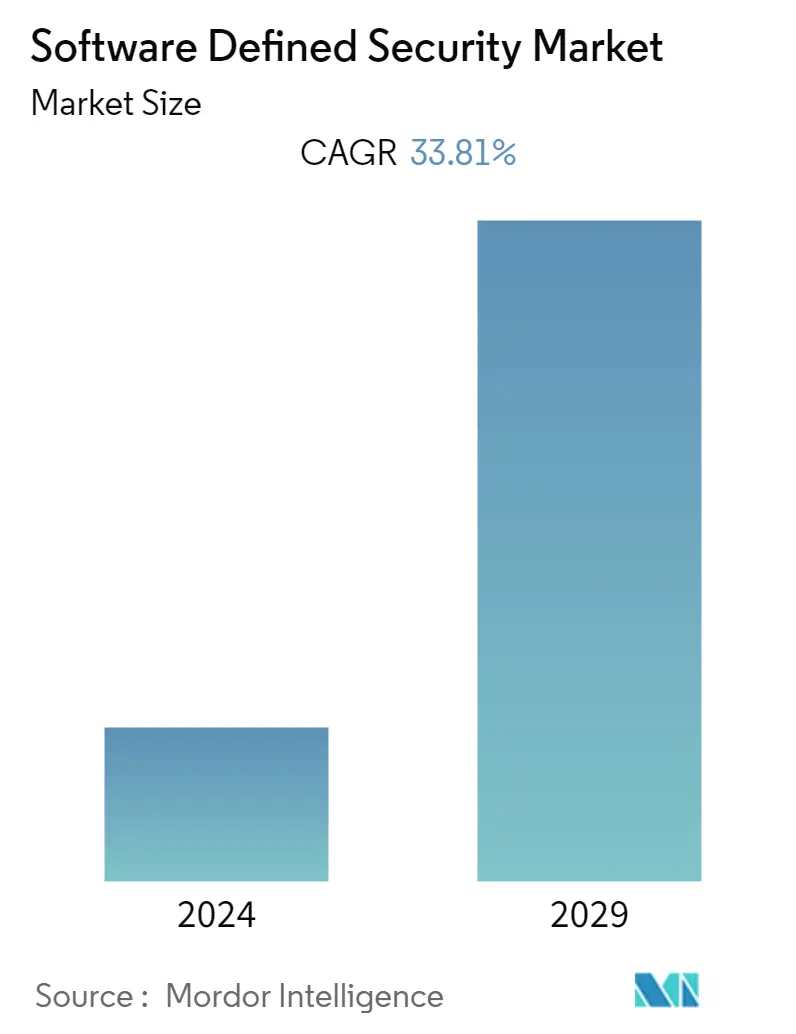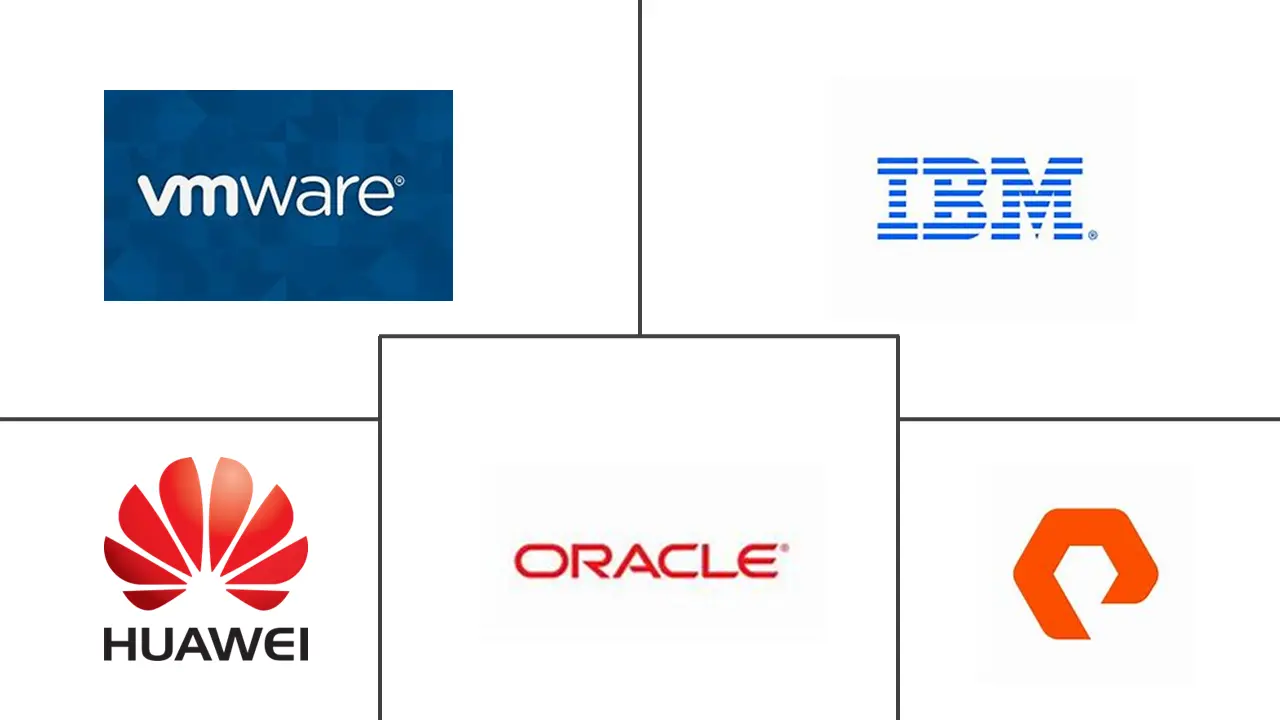Market Size of Software Defined Security Industry

| Study Period | 2019 - 2029 |
| Base Year For Estimation | 2023 |
| CAGR | 33.81 % |
| Fastest Growing Market | Asia Pacific |
| Largest Market | North America |
| Market Concentration | Low |
Major Players
*Disclaimer: Major Players sorted in no particular order |
Software Defined Security Market Analysis
The software-defined security market is expected to register a CAGR of 33.81% during the forecast period. Software-defined security is utilized in IT environments that use services of the cloud. Therefore, every time a new device enters the cloud environment, it is automatically masked and managed by the software-defined security protocol. Software-defined security systems are cost-effective and straightforward compared to traditional security models.
- Software-defined storage (SDS) is one of the new technologies trending in the enterprise storage market. SDS is part of a larger ecosystem where the software is separated from its respective hardware, revealing the freedom to choose installed hardware depending on the amount of storage needed. SDS enables cost savings while improving performance and flexibility. Thus, enterprises are slowly shifting toward software-defined storage.
- Multiple associations shape how SDS is employed across end-user industries with direct connections to major vendors, most of which are involved in similar endeavors. The Storage Network Industry Association (SNIA) sets standards for the enterprise storage industry. The established storage vendors include IBM, Dell EMC, NetApp, and emerging players, like Atlantis Computing and Falcon Star. Some offer software, like NetApp, IBM, and RedHat, while others offer hyper-converged solutions, like HPE and Dell EMC. Others, like Cisco, offer hardware and partner with SDS software vendors.
- An increase in government regulations and standards for data security, as achieved through the use of cybersecurity solutions and the installation of software, is expected to provide attractive prospects for cyber solutions in the next years. Telstra will expand its new cyber security solutions for federal, state, and municipal governments in Australia in February 2022. The Cyber Detection and Response capacity integrates with government systems and cloud-based services to monitor cyber threats using big data analytics from Telstra's managed security service platform, while Sovereign SecureEdge assists in delivering cloud security, especially in the context of a distributed workforce.
- These online security procedures are meant to ensure safety. To avoid any danger or attack, regulating genuine foundations, present frameworks should be isolated, observed, and guaranteed. Dangers associated with network security are growing, aided by the widespread use and accessibility of cloud companies such as Amazon Web Services for storing sensitive and unique data, which is expected to hinder market growth.
- Over the pandemic, software-defined storage has proven invaluable in rapidly expanding its customer base and accelerating top-line growth. For businesses during COVID-19 that continued to see unabated growth in storage but were unable to scale their Kubernetes container-based data management, there has been constant development primed toward enabling integrational capabilities across the platform case point, the previously mentioned NetApp addition of Kubernetes capability.
Software Defined Security Industry Segmentation
- Software-defined security enables the implementation of dynamic security in the network through a controller driven by software or an application. Such a security model helps shield several security-related issues, such as network segmentation, threat detection, intrusion alert, and access control, which are regulated and managed by security software. The Software-defined Security Market is segmented by Type (Block, File, Object, and Hyper-converged Infrastructure), Size of Enterprise (Small and Medium Enterprise, and Large Enterprise), End-user Industries (BFSI, Telecom, IT, Government, Other), and Geography (North America, Europe, Asia Pacific, Latin America, and Middle East and Africa). The market sizes and forecasts are provided in terms of value (USD million) for all the above segments.
| By Type | |
| Block | |
| File | |
| Object | |
| Hyper-converged Infrastructure |
| By Size of Enterprise | |
| Small and Medium Enterprise | |
| Large Enterprise |
| By End User | |
| BFSI | |
| Telecom and IT | |
| Government | |
| Other End Users |
| By Geography | |
| North America | |
| Europe | |
| Asia-Pacific | |
| South America | |
| Middle-East and Africa |
Software Defined Security Market Size Summary
The software-defined security market is poised for significant growth, driven by the increasing adoption of cloud services and the need for cost-effective and straightforward security solutions. This market leverages software-defined protocols to manage and protect IT environments, offering a more flexible and scalable approach compared to traditional security models. The rise of software-defined storage (SDS) is also notable, as it separates software from hardware, allowing enterprises to choose their hardware based on storage needs, thereby enhancing performance and reducing costs. This shift is supported by industry standards set by organizations like the Storage Network Industry Association (SNIA) and is backed by major vendors such as IBM, Dell EMC, and NetApp, alongside emerging players. The demand for cybersecurity solutions is further fueled by increasing government regulations and the need to secure cloud-based services, especially in the context of a distributed workforce.
The market landscape is highly competitive and fragmented, with numerous players offering innovative solutions to meet the growing demand for cybersecurity. Key companies like Pure Storage Inc., Huawei Technologies Co. Ltd, VMWare Inc., Oracle Corporation, and IBM Corporation are actively enhancing their product offerings to stay ahead. The Asia-Pacific region is experiencing rapid growth due to the proliferation of IoT and the need for digital transformation, presenting lucrative opportunities for SDS vendors. However, the region also faces challenges from cyberattacks, necessitating robust security measures. The market's expansion is further supported by strategic collaborations and technological advancements, such as Valeo's partnership with C2A Security and Veracode's enhancements to its security platform. These developments underscore the transformative potential of cloud infrastructure and software-defined technologies in addressing emerging security challenges.
Software Defined Security Market Size - Table of Contents
-
1. MARKET INSIGHTS
-
1.1 Market Overview
-
1.2 Industry Stakeholder Analysis
-
1.3 Market Drivers
-
1.3.1 Requirement for Quicker Response and Increased Security
-
1.3.2 Rise in Cloud Services Adoption
-
-
1.4 Market Restraints
-
1.4.1 Lack of Security Awareness in Virtualization Environment
-
1.4.2 Industry Standard Deficiency
-
-
1.5 Industry Attractiveness - Porter's Five Forces Analysis
-
1.5.1 Threat of New Entrants
-
1.5.2 Bargaining Power of Buyers
-
1.5.3 Bargaining Power of Suppliers
-
1.5.4 Threat of Substitute Products
-
1.5.5 Intensity of Competitive Rivalry
-
-
1.6 Assessment of the Impact of COVID-19 on the Market
-
-
2. MARKET SEGMENTATION
-
2.1 By Type
-
2.1.1 Block
-
2.1.2 File
-
2.1.3 Object
-
2.1.4 Hyper-converged Infrastructure
-
-
2.2 By Size of Enterprise
-
2.2.1 Small and Medium Enterprise
-
2.2.2 Large Enterprise
-
-
2.3 By End User
-
2.3.1 BFSI
-
2.3.2 Telecom and IT
-
2.3.3 Government
-
2.3.4 Other End Users
-
-
2.4 By Geography
-
2.4.1 North America
-
2.4.2 Europe
-
2.4.3 Asia-Pacific
-
2.4.4 South America
-
2.4.5 Middle-East and Africa
-
-
Software Defined Security Market Size FAQs
What is the current Software Defined Security Market size?
The Software Defined Security Market is projected to register a CAGR of 33.81% during the forecast period (2024-2029)
Who are the key players in Software Defined Security Market?
Pure Storage Inc., Huawei Technologies Co. Ltd, VMWare Inc. (Dell Inc.), Oracle Corporation and IBM Corporation are the major companies operating in the Software Defined Security Market.

